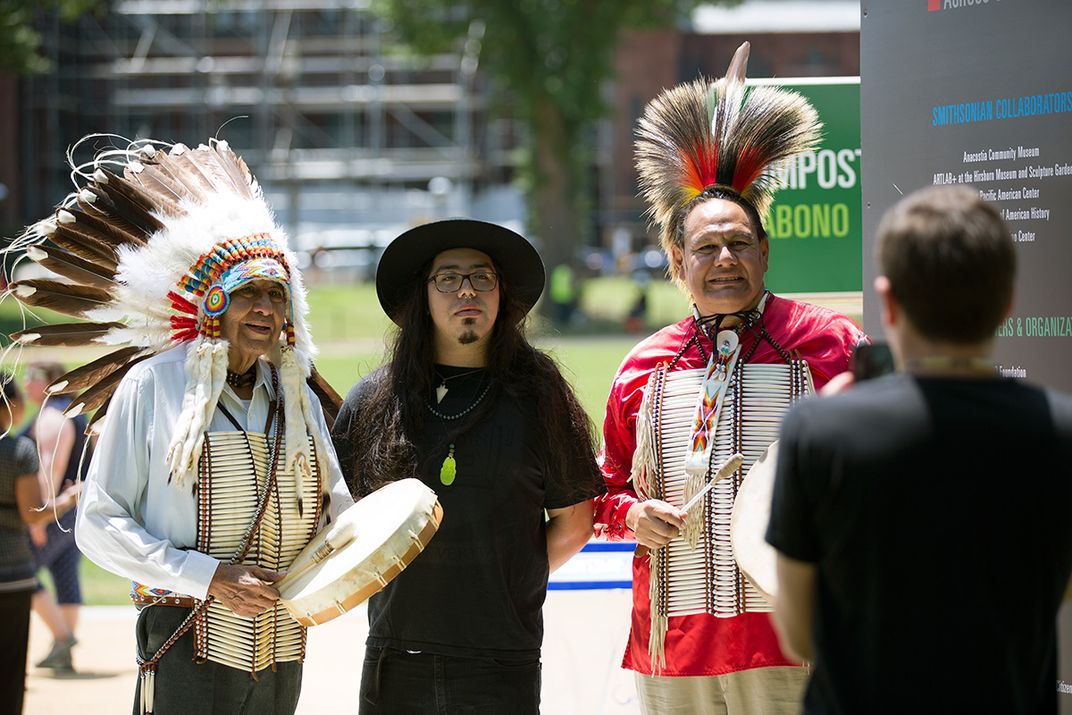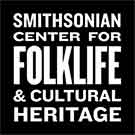SMITHSONIAN CENTER FOR FOLKLIFE & CULTURAL HERITAGE
Dennis Zotigh Is a Man of Many Talents, Many Tribes
“As Native people, we have to learn to balance two different worlds.”
:focal(600x400:601x401)/https://tf-cmsv2-smithsonianmag-media.s3.amazonaws.com/filer_public/13/1a/131a78ca-febe-46c4-866c-ea12b0f6dc21/sff2017_6-29_ap_0015.jpg)
Amid totem poles and artifacts, a drumbeat emerges, reverberating throughout all four levels of the museum. Louder and louder, the suspenseful cadence of the drum lures visitors, including me and my colleague Alexis, to someone standing in the middle of an atrium.
A man of many talents and tribes (Kiowa, Santee Dakota, and Ohkay Owingeh, to be specific), Dennis Zotigh works as a cultural specialist at the Smithsonian National Museum of the American Indian. He performs Native American song and dance to educate the general public on Native culture and contemporary issues.
An African American and Asian American, respectively, Alexis and I were interested in what Dennis had to say about embracing multicultural identity. In this excerpted interview, we explored his upbringing in New Mexico and how walking a cultural tightrope propelled him to dedicate his life to education and advocacy.
What inspired you to create the Great American Indian Dancers?
As I was growing up, my grandmother took me to the Santa Fe opera. I was exposed to ballet and orchestra, but I never saw Native people on these stages. When I saw Native people, they were dancing for pennies in a parking lot, and I thought to myself, “Dennis, why is our culture not as valuable as the finest ballets, operas, or symphonies? Something needs to be done.”
So, I organized a group of professional Native American dancers, and we performed Native dance, song, and powwows. We were brought into the local arts council, and after five years, we were accepted to Native American Alliance. Through a lot of marketing and word of mouth, the State Department started hearing of us, so then we started representing the United States in many events overseas, even performing for former President Bill Clinton.
We do what we do to preserve the past through our dances and songs, and to deliver the present. For our youth, they don’t see many heroes or icons that are our own people. We don’t see ourselves on TV or movies or on the news, unless it’s bad news. The dance company is one way we can keep our American Indian youth engaged and educated on their rich cultural background.
How was the group received by the international community?
Oh, they loved us. We were superstars! We traveled to over thirty countries sharing our culture. The interesting thing is, I made my dancers go into the audience to let the public know that American Indians are educated, that we can speak English, and that we’re passionate about what we do. We hold babies, we take pictures, that sort of thing.
I’ve heard you use “Native American” and “American Indian” interchangeably. Which term is correct?
It’s important to note that “American Indian” and “Native American” are both colonial terms built on misconception. As Native people, we would like to be identified by our tribal groups because we are comprised of many races. In reality, we are as different as German is from Japanese, and as different as Japanese is from Jamaican.
My grandfather—he was Dakota Indian—was fine with being called an American Indian, and I’m fine with it. But the generation below me became politically correct and conscious, so they began using “Native American.” We have many East Indians come [to the museum] who ask me about the distinction as well. I say it’s wrong for us because it’s a colonial term given to us, and it’s wrong for you because it’s a colonial term given to you. And every time I tell them that, they look at me and say, “Thank you for saying that.”
How did you learn about your heritage while you were growing up?
I was very lucky that my father, a fluent Native language speaker and composer, ensured that we attended tribe-specific and inter-tribal stuff so we could continue our culture in a city setting. He was a singer, his father was a singer, and his father before him was a singer.
My father was important in the New Mexico area. He was a pioneer of the powwow, a Native American gathering that involved dancing, singing, and feasting. The very first powwow in New Mexico took place on a flamenco dancer’s stage. There were only about twenty people from many different tribes, trying to bring together their collective “Indian-ness” to an urban setting. It was small and humble. Today, six miles south of that flamenco dancer’s stage is the world’s largest powwow in an Indian gathering event. And I saw the evolution. It was incredible. It still is.
Was there tension between your upbringing and your father’s?
In the 1800s, prior to the reservations, Native American children were institutionally kidnapped by the U.S. government. Our children, as young as four years old, were put in boarding schools to “Americanize” them. When they tried to speak their language, they were beaten. They were stripped of their identities, taught to march, and taught to say Pledge of Allegiance to a flag they didn’t understand. The children would sneak off and try to get back to their communities. A lot of them died. They were lonesome, they wanted their moms, and they wanted to be held and told they were loved.
My father was a product of the boarding school. He’s never told me he loved me because showing emotion in the boarding school was a sign of weakness. And I hope someday he does. I hope someday he holds me and says, “I love you.” I know he does, but he’s just never told me.

Juggling multiple cultures can be hard, especially for a child. How would you advise younger generations to embrace their multicultural identities?
We grew up American. I grew up in Albuquerque, New Mexico, which was very different from growing up on a reservation. As a child, I never knew I was different, but I remember learning that I was different in high school. While all the other students were in the common area hanging out or eating, I was in the library finishing up my homework and reading every Native book I could find. I learned then that I was different, and I have a rich heritage that I should be proud of.
Identity is a problem many young people wrestle with. As Native people, we have to learn to balance two different worlds. That’s what’s really important about today. For American Indian people, it’s hard when all your icons that are Indian are interpreted by non-Indian people. For example, the labels we see, they’re derogatory. Our young people don’t realize that we do have a beautiful culture.
Get a good education, but remember your roots and who you are, because if you don’t, our culture is going to die with you.
What drives you to do what you do?
I’m at a point where I can make a difference. I’m in a very visible area where my job allows me to say, “No matter how painful it is, let’s talk about it, let’s get it out in the open.” This is something we haven’t had in the past. Especially now, many educators and visual storytellers across America are scared to overstep their boundaries when portraying Native people, so then they don’t teach anything. But that doesn’t help either.
I think a good first step would be to include consultation of various Natives to get several viewpoints. It’s good for Native voices to be active in the interpretation so that it can actually represent the people it’s about. Our culture is what makes us unique, and our story needs to be told.
November is National Native American Heritage Month. See the events hosted by the Smithsonian and partner organizations.
Laura Zhang is studying neuroscience and Plan II Honors at The University of Texas at Austin. Currently, she is an intern at the Center for Folklife and Cultural Heritage and exudes a passion for social justice, stories, and dogs of all kinds.
